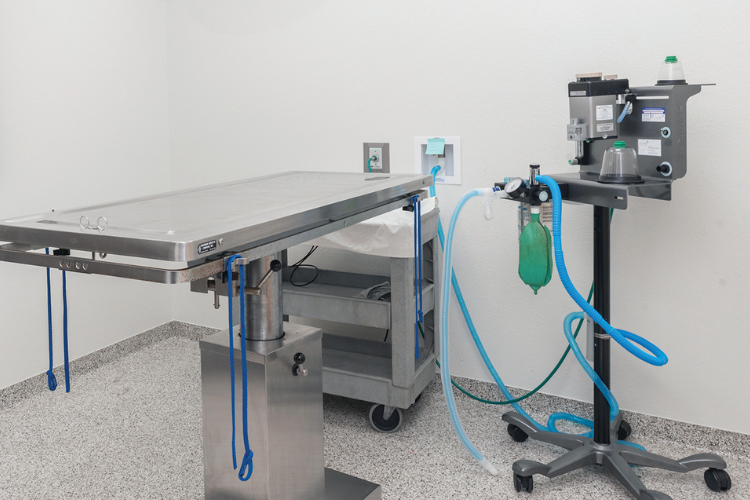If veterinarians were asked to name their top areas for traffic flow bottlenecks in their practice, surgical and dental suites would rise to the top of the list. With needing to accommodate a table and patient, the care team, the instrument tray and the suite’s equipment, even the largest rooms can fill up fast.
Furthermore, in practices with extremely small footprints and no room to expand, these areas may do double duty as non-surgical procedure spaces, where unneeded equipment with a larger footprint still wouldn’t be appreciated.
With these concerns in mind, most practices consider space savings as they look at anesthesia equipment. Below are four of the most frequently used options for decreasing the space anesthesia equipment takes. We’ve included information on how they minimize their room, when they’re typically chosen and how they can be implemented without causing other issues for the practice.
1. Go wall-mounted
Mounting a machine to the wall, like a picture frame, positions it out of the way but always nearby. Even better, the monitor and vaporizer can be mounted adjacent to the machine, further saving space and keeping everything convenient.
Tia Piering, director of manufacturing at Patterson Veterinary, said both Patterson’s Versa II and Compact machines have been regularly used as wall-mounted systems. The Versa II has a fixed and swivel wall-mount version that saves space, and the Compact mounts flush to the wall.“It not only saves space; in the end, dedication is nice to have. You know it’s always going to be there. Nobody’s going to take it out of the room.”
2. Go smaller, but don’t sacrifice power and function

It’s obvious: smaller machines just fit into practices more easily. Patterson’s Compact anesthesia machine can snugly fit onto a tabletop, a pole or the wall. But reduced size doesn’t translate to reduced functionality.
“The reason we came up with this system was for a clinic in New York City where floor space was at a premium. Our Versa, at the time, was just too big for their space. It was our inspiration to design the Compact to be a smaller unit,” said Piering.
3. Go tall, not wide

The necessary presence of monitors, vaporizers and concentrators can quickly take up any space savings from smaller machines.
One way to avoid this problem is to stack other equipment on top of the base unit or to be able to hang items, such as the concentrator, on the machine. It’s particularly easy to do with machines that are mounted on a pole or stand. In the end, this strategy is all about going taller rather than extending a footprint out.
4. Go portable

Portable equipment on a rolling stand can alleviate space concerns when a suite needs to be available for non-surgical procedures. It’s also ideal for practices with a mobile component to their care team that require field-based, portable machines, practices with a dental suite that doesn’t need a dedicated machine or for vets who need to move anesthetized patients between various areas of their practice, such as between X-ray and a procedure room.
One notable drawback to the approach is machine availability. Said Piering, “It could happen that the units might not be present in a space when a provider needs it. Careful scheduling should mitigate this risk somewhat, but in busy practices conflicts can still happen.”
This article was originally published in our October 2024 edition of Insight magazine. If you're interested in more anesthesia-focused content, read the digital version HERE, where you'll discover additional exclusive pieces on this subject and others.
Share
Related blogs

Design Solutions to 6 Pesky Practice Problems
Senior designer April Cuellar is part of a Patterson Veterinary Hospital Design team that advises on more than 300 clinics a year. She shares how design can help with six of the most frequent challenges practices face.

6 Sneaky Signs Your Dental Unit Might Need Maintenance
Issues with dental units can sneak up on veterinary practices. Even subtle problems can impact patient care and add stress to your practice. Fortunately, it’s possible to catch issues early! We've gathered six sneaky signs that can alert you to problems.

Top 7 Questions From our Impact of OSHA Changes Webinar
If you missed our Impact of OSHA'S Hazard Communication Standard 2024 webinar, don't worry - we got you! In this post, we're reviewing seven of the most-asked questions, as well as outlining what has recently changed.

